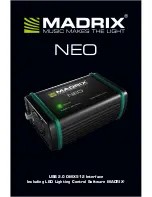
Page
4
of
23
•
Keep a working fire extinguisher in the work area at all times.
Personal Protective Equipment
•
Wear all appropriate personal protective equipment when operating
equipment and/or when in the work area. Personal protective equipment
(P.P.E.) can help prevent serious injury, including eye injury, hearing loss,
inhalation of toxins, fumes and dust.
•
P.P.E. includes hearing protection, eye protection, protective clothing, shoes and gloves.
•
Properly fit-tested and government approved respirator that is suitable for the collection of
dust.
Misuse of equipment can cause death or serious injury.
•
Do not use equipment if fatigued or under the influence of drugs or alcohol.
•
Do not exceed the maximum working pressure or temperature rating of the
equipment (see Manufacture’s Data Report).
•
Always be aware that blast nozzle may have a recoil effect when activating trigger.
•
Do not use equipment without proper hose safety cables or hose safety clips.
•
Do not operate equipment on an unstable surface.
•
Do not leave equipment unattended without depressurizing all air hoses.
•
Check equipment daily. Replace all worn or damaged components with genuine
manufacture’s replacement parts.
•
Do not alter or modify equipment. Modifying/altering equipment will render system unsafe
and will void warranty.
•
Only use equipment for its intended purpose.
•
Route all hoses away from high traffic areas. Anything lying on the ground is considered a
tripping hazard.
•
Do not kink, over bend hoses or use hoses to move equipment.
•
Keep children and animals away from equipment and work area.
•
Always comply with all safety regulations.





































